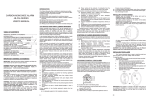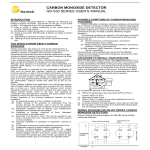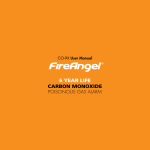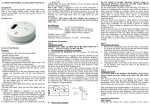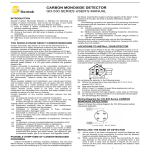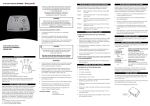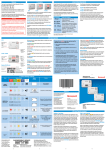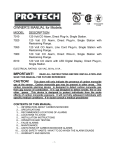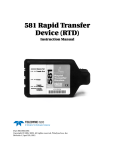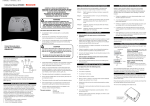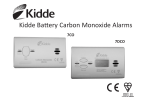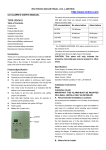Download c06 璇存槑涔﹀嵆co涓 €ц 鏄庝功淇 敼
Transcript
INTRODUCTION CARBON MONOXIDE ALARM MONUMX-JBC01 USER’S MANUAL This Carbon Monoxide Alarm is effective for detecting any buildup of carbon monoxide, also known as CO gas, in your home or office. The feature of your CO gas alarm includes: (1) Easy to install. (2) Monitoring for carbon monoxide in a continuous manner. (3) Giving a loud alarm (85 dB) when it detects a buildup of carbon monoxide. (4) Having a Test button for you to test the alarm anytime. (5) Self-testing its operative function continuously. (6) Complying the requirements of EN50291. (7) Offering a 5-year warranty for the carbon monoxide sensing unit YOU SHOULD KNOW ABOUT CARBON MONOXIDE TABLE OF CONTENTS IMPORTANT WARNING STATEMENTS……………………….1 INTRODUCTION……………………………………………...........1 YOU SHOULD KNOW ABOUT CARBON MONOXIDE…..........1 SYMPTOMS OF CARBON MONOXIDE POISONING……..…..2 LOCATIONS TO INSTALL YOUR ALARM …….....................…2 INSTALLING YOUR ALARM ….....……......………………….....2 TESTING AND RESETTING YOUR ALARM…....... ……… .. 2 TAKING CARE OF YOUR ALARM ….................……………....2 MEANING OF LED LIGHT & BUZZER…………………..............2 ACTIONS TO DO WHEN ALARM SOUNDING………...............3 ACTIONS TO DO AFTER THE PROBLEM HAS BEEN CORRECTED…………………………………………..……..........3 TECHNICAL INFORMATION….........………………………….....3 WARNING AND LIMITATION…………………………….............3 SERVICE OR REPAIR INFOR MATION………………………....3 WARRANTY INFORMATION……………………………............. 3 IMPORTANT WARNING STATEMENTS IMPORTANT: Read all instructions before installation and keep this User’s Guide near the alarm for future reference. WARNING: Removal of the alarm batteries will render the alarm inoperative. This alarm requires a continuous supply of electrical power – it will not work without power. CAUTION: This alarm will only indicate the presence of carbon monoxide at the sensor. Carbon monoxide may be present in other areas. This product is intended for use in ordinary indoor locations of family living units. It is not designed to measure compliance with Occupational Safety and Health Administration (OSHA) commercial or industrial standards. It is not suitable for installation in hazardous locations as defined in the National Electric Code. WARNING: This device is designed to protect individuals from acute effects of carbon monoxide exposure. It may not fully safeguard individuals with specific medical conditions. If in doubt, consult a medical practitioner. Individuals with medical problems may consider using warning devices which provide audible and visual signals for carbon monoxide concentrations under 30 PPM. This alarm has not been investigated for carbon monoxide detection below 70 PPM. Carbon monoxide, also known as "CO" by the chemical form, is considered to be a highly dangerous poisonous gas, because it is colorless, odorless or tasteless and very toxic. In general, biochemistry phenomena have shown that the presence of CO gas inhibits the blood's capacity to transport oxygen throughout the body, which can eventually lead to brain damage. In any enclosed space (home, office, recreational vehicle or boat) even a small accumulation of CO gas can be quite dangerous. Although many products of combustion can cause discomfort and adverse health effects, it is CO gas which presents the greatest threat to life. Carbon monoxide is produced by the incomplete combustion of fuels such as natural gas, propane, heating oil, kerosene, coal, charcoal, gasoline, or wood. The incomplete combustion of fuel can occur in any device which depends on burning for energy or heat such as furnaces, boilers, room heaters, hot water heaters, stoves, grills, and in any gasoline powered vehicle or engine (e.g. generator set, lawnmower). Tobacco smoke also adds CO to the air you breathe. When properly installed and maintained, your natural gas furnace and hot water heater do not pollute your air space with CO. Natural gas is known as a "clean burning" fuel because under correct operating conditions, the combustion products are water vapor and carbon dioxide (CO2), which is not toxic. The products of combustion are exhausted from furnaces and water heaters to the outside by means of a fuel duct or chimney. The following conditions can result in transient CO situations: 1) Excessive spillage or reverse venting of fuel burning appliances caused by outdoor ambient conditions such as wind direction and/or velocity, including high gusts of wind; heavy air in the vent pipes (cold/humid air with extended periods between cycles). 2) Negative pressure differential resulting from the use of exhaust fans. 3) Simultaneous operation of several fuel burning appliances competing for limited internal air. 4) Vent pipe connection vibrating loose from clothes dryers, furnaces, or water heaters. 5) Obstructions in or unconventional vent pipe designs which amplify the above situations. 6) Extended operation of unvented fuel burning devices (range, oven, fireplace, etc.). 7) Temperature inversions which can trap exhaust gasses near the ground. 8) Car idling in an open or closed attached garage, or near a home. Correct operation of any burning equipment requires two key conditions: (a) An adequate supply of air for complete combustion. 1 (b) Proper venting of the products of combustion from the furnace through the chimney, vent or duct to the outside. Typical carbon monoxide gas problems are summarized here: (a) Equipment problems, due to defects, poor maintenance, damaged and cracked heat exchangers (b) Collapsed or blocked chimneys or flues, dislodged, disconnected or damaged vents (c) Downdraft in chimneys or flues. This can be caused by very long or circuitous flue runs, improper location of flue exhaust or wind conditions (d) Improper installation or operation of equipment, chimney or vents (e) Air tightness of house envelop/inadequate combustion of air (f) Inadequate exhaust of space heaters or appliances (g) Exhaust ventilation/fireplace competing for air supply Potential sources of carbon monoxide in your home or office include clogged chimney, wood stove, wood or gas fireplace, automobile and garage, gas water heater, gas appliance, gas or kerosene heater, gas or oil furnace, and cigarette smoke. furnaces, stoves and fireplaces (d) In exhaust streams from gas engines, vents, flues or chimneys (e) Do not place in close proximity to an automobile exhaust pipe; this will damage the alarm INSTALLING YOUR BATTERIES Batteries were not installed at the factory and must be installed for the unit to operate. Install the 9v battery in the back of the CO alarm. The battery polarity markings on the bottom of the battery compartment must be adhered to. Battery must be installed in the sequence shown following. If battery seems difficult to install, they’re being installed in the proper sequence. SYMPTOMS OF CARBON MONOXIDE POISONING The following symptoms are related to CO poisoning and should be discussed with all members of the household so that you know what to look for: (1) Mild Exposure: Slight headache, nausea, vomiting, fatigue (often described as “Flulike” symptoms). (2) Medium Exposure: Severe throbbing headache, drowsiness, confusion, vomiting, fast heart rate. (3) Extreme Exposure: Unconsciousness, convulsions, cardio respiratory failure, death. Many cases of reported CARBON MONOXIDE POISONING indicate that while victims are aware they are not well, they become so disoriented they are unable to save themselves by either exiting the building or calling for assistance, Young children and household pets are typically the first affected. Exposure during sleep is particularly dangerous, because the victim usually does not awaken. LOCATIONS TO INSTALL YOUR ALARM Since CO gas moves freely in the air, the suggested location is in or as near as possible to sleeping areas of the home. The human body is most vulnerable to the effects of CO gas during sleeping hours. For maximum protection, a CO alarm should be located outside primary sleeping areas or on each level of your home. In the figure below, are suggested locations in the home. The electronic sensor detects carbon monoxide, measures the concentration and sounds a loud alarm before a potentially harmful level is reached. Do not place the alarm in the following areas: (a) Where the temperature may drop below 40oF (4.4oC) or exceed 100oF (37.8oC) (b) Near paint thinner fumes (c) Within 5 feet (1.5 meter) of open flame appliances such as CO alarm will not engage the attachment stud unless battery is installed. If any form of battery failure is detected the red LED will flash and the unit will “chirp” once every 30 seconds, and will continue for at least seven days, it means the battery should be replaced. Replace battery with GP 1604. WARNING: Use only the batteries specified. Use of different batteries may have a detrimental effect on the CO alarm. INSTALLING YOUR ALARM This Carbon Monoxide Alarm is easy to install to protect you and your family in your home, cottage, cabin and office. To install the alarm: The alarm should be wall mounted using the fixings provided. Wall mounting installation: 1. At the place where you are going to install the alarm, draw a horizontal line 3.30 inches (84mm) long. 2. Using a 3/16-inch (5 mm) drill bit, drill two holes at the end of the line and insert wall plugs. 3. Using the two screws and wall plugs (all supplied), don’t screw too firmly into the wall. 4. Hung the alarm on the protruding fixing pin using the ‘keyholes’ on the back. IMPORTANT: Not suitable as a smoke or fire alarm. This device is not suitable for installation in a hazardous location, as defined the National Electrical Code. Do not use alarm in an outlet that is controlled by a wall switch. 2 TESTING YOUR ALARM A red light indicates that power is supplied. To test the alarm (do not test when alarm is at warm up mode), press the test button and the alarm will beep intermittently and the red LED will flash. Release the Test button, the beep and the red LED will stop and flash every 30s. A malfunctioning unit is indicated by beep-sounding on and off sequentially, i.e., beeping twice every 30 seconds. If this occurs, attempt to disconnect the power supply to the unit for 10 seconds and then power the unit again. Should the unit again beep intermittently, DO NOT uses this alarm. Send the malfunctioning unit to the manufacturer for servicing. TAKING CARE OF YOUR ALARM You have to maintain the alarm frequently to ensure it working properly. Few tips are provided for you to take care of your alarm: (a) Use a vacuum cleaner to clean the air vents occasionally to keep them free of dust. (Before cleaning your unit, unplug it from the wall outlet or.) (b) Push the Test button on your alarm to test its operating function once every week. OPERATION OF THE ALARM (a) Normal Operation When no carbon monoxide is present, the green power light will flash approximately once every 30 seconds. (b) Alarm Condition When the unit detects carbon monoxide, it will give the alarm signal continuously. The red alarm light will flash and the buzzer will sound approximately 3 times per 4 seconds. (c) Hush Feature If required, the audible alarm can be silenced for 8 minutes by pushing the button marked ‘Test/Hush’The r.e d alarm light will continue to flash. If carbon monoxide is still present after the 8 minutes hush period, the audible alarm will sound. (d) Fault Warning If a fault is detected the buzzer will sound 2 short chirps every 30 seconds. The alarm must then be replaced. (e) Battery Fault Warning The buzzer will sound 1 short chirp every minute. Note: The red LED flash every 200ms and buzzer beeps as the sequence that 3 beeps, pause, 3 beeps pause, when you press the Test button. ACTIONS TO TAKE WHEN ALARM SOUNDING In case of harmful levels of CO gas being detected, your alarm will go into a continuous full alarm. Try to take the following necessary actions immediately: (a) If there is anyone experiencing the effects of carbon monoxide poisoning such as headache, dizziness, nausea or other flu-like symptoms, call emergency right away. You should evacuate all the people in the premises immediately. Do a head count to check that everybody is accounted for. (b) Do not re-enter the premises until the problem has been corrected and the CO gas has been dispersed out and a safe level is reached. (c) If no symptoms exist, immediately, ventilate the home by opening windows and doors. Turn off fuel burning appliances and call a qualified technician or your utility company to inspect and repair your problem before restarting appliances. WARNING: Actuation of your CO alarm indicates the presence of carbon monoxide (CO) which can KILL YOU. If alarm signal sounds: 1) Operate reset/silence button; 2) Call your emergency services (Telephone Number) 3) Immediately move to fresh air – outdoors or by an open door/window. Do a head count to check that all persons are accounted for. Do not reenter the premises nor move away from the open door/window until the emergency services responders have arrived, the premises have been aired out, and your alarm remains in its normal condition. 4) After following steps 1 – 3, if your alarm reactivates within a 24 hour period, repeat steps 1 – 3 and call a qualified appliance technician ( ) to investigate for sources of CO from fuel burning equipment and appliances, and inspect for proper operation of this equipment. If problems are identified during this inspection have the equipment serviced immediately. Note any combustion equipment not inspected by the technician and consult the manufacturers’ instructions, or contact the manufacturer directlys, for more information about CO safety and this equipment. Make sure that motor vehicles are not, and have not been, operating in an attached garage or adjacent to the residence. WARNING: Normally an activation of the alarm indicates the presence of CO gas. However, the CO gas can be extremely fatal, if it is not detected. The source of the CO gas may come from several possible situations, please refer to the list of sources of carbon monoxide in page 1. CAUTION: This alarm will only indicate the presence of CO gas at the sensor. However, you have to be aware that the CO gas may be present in other areas in the premises. ACTIONS TO TAKE AFTER THE PROBLEM BEING CORRECTED ALARM SOUNDER Once the problem about the CO gas presence in the premises has been corrected, the alarm of the alarm should be off. After waiting for 10 minutes, push the Test button to test the alarm so that you can make sure that the alarm is working properly again. TEST/HUSH BUTTON RED LED MONUMX-JBC01 SPECIFICATIONS: Model: Gas Detected: Detection Principle: 3 MONUMX-JBC01 Carbon monoxide Electro-chemical cell Power supply 9V Alkaline batteries Alarm Indication: Flashing red light and audible alarm Audible Alarm: 85dB minimum at 10 feet Alarm levels: EN50291 Standard 300ppm within 3 minutes 100ppm within 40 minutes 50ppm within 90 minutes Operating temperature 0oC to 49oC Humidity Range: 30 to 90%RH Dimensions 98mm×56mm×31.5mm to the period of one (1) year on the alarm and five (5) years on the sensing unit starting from the date of purchase. in no case shall the Company be liable for any consequential or incidental damages for breach of this or other warranty, expressed or implied whatsoever, even if the loss or damage is caused by the Company's negligence or fault. Some states do not allow the exclusion or limitation of incidental or consequential damages, so the above limitation or exclusion may not apply to you. This warranty gives you specific legal rights, and you may also have other rights which vary from state to state. WARNING AND LIMITATION This alarm may not alarm at low carbon monoxide levels. The Occupational Safety and Health Association (OSHA) has established that continuous exposure levels of 30 ppm should not be exceeded in an 8 hours period. Individuals with a medical problem may consider more sensitive detection devices. The CO gas alarm is not suitable as a smoke or fire alarm. This alarm is not suitable to install in a hazardous location, as defined in the National Electrical Code. This alarm will not work without power. MONUMX-JBC01 Carbon Monoxide Alarm will not work if the power supply is disconnected or cut off or remove the batteries for any reason. Additionally, carbon monoxide must reach the alarm for the proper performance of CO gas detection. Carbon monoxide alarms may wear out because they contain electronic parts that fail at any time. Test your alarm at least every week (see the section "TESTING YOUR ALARM"). SERVICE OR REPAIR INFORMATION For service or repair, return your MONUMX-JBC01 Carbon Monoxide Alarm intact, stating the reason for return and details of any fault, to the distributor who supplied the product. WARRANTY INFORMATION Limited Warranty: MONUMX-JBC01 Carbon Monoxide Alarm sensor to be free from defects in material and workmanship under normal use and service for a period of five (5) years from date of purchase. We warrant Carbon Monoxide Alarm, other than the sensor, to be free from defects in material and workmanship under normal use and service for a period of one (1) year from date of purchase. makes on other express warranty for this Carbon Monoxide Alarm. No agent, representative, dealer or employee of the Company has the authority to increase or alert the obligation of this warranty shall be limited to repair or replacement of any part of the alarm which is found to be defective in materials or workmanship under normal use and service during the first (1) year period starting from date of purchase except for the sensor which is warranted during the five (5) year period starting from date of purchase. During the later four (4) years of the warranty period, such repair or replacement other than the sensor itself, shall be charged to the customer not to exceed the manufacturer's cost. The Company shall not be obligated to repair or replacement units which are found to be in need of repair because of damage, unreasonable use, modifications, or alterations occurring after the date of purchase. The duration of any implied Warranty, including that of merchantability of fitness for any particular purpose, shall be limited MONUMX-JBC01 Ultra Max Batteries, London N18 2NG 4 Conforms to EMC Regulations V1I14


